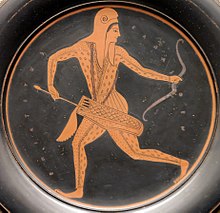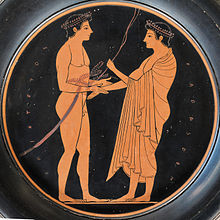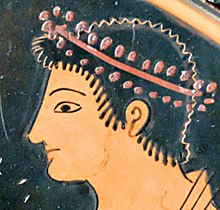Epiktetos
Epictetus (ancient Greek Ἐπίκτητος) was an Attic vase painter of the early red-figure style. Next to Oltos, the most important red-figure bowl painter of the pioneer period worked between about 520 and 490 BC.
At the beginning of his career Epictetus painted a goblet crater made by the potter Andokides, but thereafter turned to smaller vessels such as bowls and plates. He worked for various potters, besides Andokides also for Hischylos and the Nikosthenes-Pamphaios workshop. One plate he signed as a painter and potter, so he was probably both at times. This plate was a votive offering he made at the Acropolis. On one dish he collaborated with the Euergides painter. He was evidently aware of his artistry; almost half of the more than 100 works attributed to him are signed by him.
His first works were bilingual eye bowls. Here he was already technically better than, for example, Oltos in his early works and showed, for example, no outmoded red palm hearts. In addition, he used the relief line. Epictetus is considered to be a master of circular pictures (tondi). So it is not surprising that he not infrequently decorated his bowls only on the inside. He was very precise even in miniaturistic works. He used colours and ornaments in a very restrained way. In addition, he showed great balance in the lines and detailed drawings. Heads and limbs were well proportioned. His figures appear very convincing in their plasticity. John D. Beazley praises Epictetus wholeheartedly: "You can't draw better, you can only draw differently". John Boardman also joins in the praise, calling him "the greatest draughtsman of early red-figure vase painting".
His motifs are interesting not least from a modern point of view. Although he rarely shows mythical scenes, which, moreover, are not particularly original, his depictions of everyday life are all the more significant. He shows citizens at play, at symposion, and in erotic scenes, from which he derives some new aspects and motifs. He did important work in elaborating the satyr into a figure embodying animal masculinity. His circular paintings no longer show the "knee runners" typical of the black-figure style; he shows his figures kneeling, squatting or sitting. There are shells on which the posture of the figure depicted is almost identical, but the action varies greatly. Thus a bent and turning figure is shown once as Minotaur, a second time as a man masturbating into a chamber pot, a third time as a girl satisfying herself with a dildo.
The end of his career is difficult to pin down. One of his later works is on a bowl of the potter Python - here he also seems to be stylistically influenced by Python's most important painter Douris -, another for Pistoxenos. Apparently Epiktetos' work was quite recognized, for there is the signature Epiktetos egraphsen - Epiktetos painted it - twice on a pelike of the Kleophrades painter. The signature is today considered an ancient forgery, which was thus meant to lure with the name of the well-known painter Epictetus.

Scythian archer, facing backwards while running and drawing an arrow from his quiver, bowl c. 520/00 BC.

Palestra scene on a plate, c. 520/10 BC.

Detail of a head of the palestra scene
Search within the encyclopedia